Simulation of Microclimate and PM2.5 Dispersion in Typical Urban Parks in Beijing Based on the ENVI-Met Model
Abstract
1. Introduction
2. Materials and Methods
2.1. Site Description
2.2. Data Acquisition
2.3. ENVI-Met Simulation Method Based on Remote Sensing Data
2.3.1. Image Import and Model Configuration
2.3.2. Parameter Settings
2.3.3. Evaluating the Accuracy of Simulations on the Basis of the RMSE and MAPE
3. Results
3.1. Image-Based Model Construction
3.2. Analysis of the Microclimate and PM2.5 Diffusion Simulation in the Parks
3.2.1. Analysis of the Microclimate and PM2.5 Diffusion Simulation in Parks During the Summer
3.2.2. Analysis of the Microclimate and PM2.5 Diffusion Simulation in Parks During the Spring
3.2.3. Analysis of the Microclimate and PM2.5 Diffusion Simulation in Parks During the Winter
3.3. Comparison Between Simulated and Observed Values
3.3.1. Temperature
3.3.2. Relative Humidity
3.3.3. Wind Speed
3.3.4. PM2.5 Concentration
3.4. Evaluating the Accuracy of Simulation on the Basis of the RMSE and MAPE
4. Discussion
5. Conclusions
Author Contributions
Funding
Institutional Review Board Statement
Informed Consent Statement
Data Availability Statement
Acknowledgments
Conflicts of Interest
References
- Wang, Y.; Shi, P.; Zhao, W.; Wang, Z.; Xie, X. Spatial-temporal characteristics and influencing factors of thermal environment in Lanzhou. Ecol. Sci. 2022, 41, 59–65. [Google Scholar] [CrossRef]
- Manley, G. On the frequency of snowfall in metropolitan England. Q. J. R. Meteorol. Soc. 1958, 84, 70–72. [Google Scholar] [CrossRef]
- Nie, J.; Zhang, J.; Huang, B. A review of the human health consequences of urban heat island effect. Ecol. Sci. 2021, 40, 200–208. [Google Scholar] [CrossRef]
- Peng, X.; Zou, H.; He, Z. Influence of urban heat island effect on urban ecological system and research of antidote. Jiangxi Sci. 2003, 3, 257–259. [Google Scholar] [CrossRef]
- Shen, S.; Liu, L.; Wen, W.; Xing, Y.; Su, W.; Sun, J.Q. Pollution characterization and source analysis of carbon components of PM2.5 in Beijing and surrounding areas in summer. Environ. Eng. 2022, 40, 71–80. [Google Scholar] [CrossRef]
- Oke, T.R.; Crowther, J.M.; McNaughton, K.G.; Gardiner, B. The micrometeorology of the urban forest and discussion. Philos. Trans. R. Soc. Lond. B 1989, 324, 335–349. [Google Scholar] [CrossRef]
- Huang, Y.J.; Akbari, H.; Taha, H.; Rosenfeld, A.H. The potential of vegetation in reducing summer cooling loads in residential buildings. J. Clim. Appl. Meteorol. 1987, 26, 1103–1116. [Google Scholar] [CrossRef]
- Taha, H. Urban climates and heat islands: Albedo, evapotranspiration, and anthropogenic heat. Energy Build. 1997, 25, 99–103. [Google Scholar] [CrossRef]
- Chen, Z.; Chen, F.M.; Zhu, F.G.; Cao, L.; Shen, X.H.; Li, J.X. Effects of park size and plant community structure on urban park air temperature. Chin. J. Ecol. 2011, 30, 2590–2596. [Google Scholar] [CrossRef]
- Dimoudi, A.; Nikolopoulou, M. Vegetation in the urban environment: Microclimatic analysis and benefits. Energy Build. 2003, 35, 69–76. [Google Scholar] [CrossRef]
- Zhang, F.; Li, L. Spatial microclimate simulation of plant community based on human comfort—Taking Olympic Forest Park as an example. J. Beijing Univ. Civ. Eng. Archit. 2020, 36, 30–39. [Google Scholar] [CrossRef]
- Zhu, L.; Gu, K.; Fang, Y. Study on the correlation between space form of urban residential areas and PM2.5 concentration based on ENVI-met. Ecol. Environ. Sci. 2019, 28, 1613–1621. [Google Scholar] [CrossRef]
- Sun, L. Research on shrubs of temperature and moisture and numerical computation. China Univ. Min. Technol. 2015. Available online: https://kns.cnki.net/KCMS/detail/detail.aspx?dbname=CMFD201601&filename=1015972290.nh (accessed on 10 January 2025).
- Qin, W.; Hu, D.; Li, Y.; Guo, Z. Numerical simulation of microclimate in Beijing typical residential area based on ENVI-met model. J. Meteorol. Environ. 2015, 31, 56–62. Available online: https://d.wanfangdata.com.cn/periodical/ChVQZXJpb2RpY2FsQ0hJMjAyNTA2MjISDWxucXgyMDE1MDMwMDkaCGRnemRwYzJs (accessed on 10 January 2025).
- Lao, Z.; Li, Y.; Deng, X.; Li, Y. Numerical simulation of thermal environment in Zhongshan urban streets based on ENVI-met. Chin. Environ. Sci. 2017, 37, 3523–3531. [Google Scholar]
- Ma, T. Study on microclimate measurement and simulation in Hohhot urban park—Take Aertai park for example. Inner Mongolia Univ. Technol. 2018. Available online: https://kns.cnki.net/kcms/detail/detail.aspx?filename=1018795391.nh (accessed on 10 January 2025).
- Vos, P.E.J.; Maiheu, B.; Vankerkom, J.; Janssen, S. Improving local air quality in cities: To tree or not to tree. Environ. Pollut. 2013, 183, 113–122. [Google Scholar] [CrossRef]
- Nikolova, I.; Janssen, S.; Vos, P.; Berghmans, P. Modelling the mixing of size resolved traffic induced and background ultrafine particles from an urban street canyon to adjacent backyards. Aerosol Air Qual. Res. 2014, 14, 145–155. [Google Scholar] [CrossRef]
- Wang, Y.; Qiao, Y.; Wang, N. Application of CFD simulation in urban microclimate in China. J. Chin. Urban For. 2021, 19, 53–60. [Google Scholar] [CrossRef]
- Bruse, M.; Fleer, H. Simulating surface-plant-air interactions inside urban environments with a three-dimensional numerical model. Environ. Softw. Model. 1998, 13, 373–384. [Google Scholar] [CrossRef]
- Detommaso, M.; Costanzo, V.; Nocera, F. Application of weather data morphing for calibration of urban ENVI-met microclimate models: Results and critical issues. Urban Clim. 2021, 38, 100895. [Google Scholar] [CrossRef]
- Liu, Z.; Cheng, W.; Jim, C.Y.; Morakinyo, T.E.; Shi, Y.; Ng, E. Heat mitigation benefits of urban green and blue infrastructures: A systematic review of modeling techniques, validation and scenario simulation in ENVI-met V4. Build. Environ. 2021, 200, 107939. [Google Scholar] [CrossRef]
- Fan, S.; Zhang, D.; Tian, L.; Li, X.; Guo, J.; Lin, Y. Emission inventory and spatial distribution of road fugitive dust PM2.5 in Beijing. Res. Environ. Sci. 2016, 29, 20–28. (In Chinese) [Google Scholar]
- Zhang, W. Numerical Study of the Impact of Green Space Layout on Microclimate in Residential District. Master’s Thesis, Nanjing University, Nanjing, China, 2015. Available online: https://kns.cnki.net/kcms/detail/detail.aspx?filename=1015321521.nh (accessed on 10 January 2025).
- Zhao, Z. Research on microclimate simulation and optimization strategy of university campus based on ENVI-met: Taking Shenyang Agricultural University as an example. Master’s Thesis, Yanbian University, Yanbian, China, 2024. (In Chinese). [Google Scholar]
- Zhang, X.; Nie, Q.; Liu, J. Research on urban geothermal comfort improvement strategy based on ENVI-met. Ecol. Sci. 2021, 40, 144–155. [Google Scholar] [CrossRef]
- Wang, X.; Zhang, Y.; Zhang, J.; Fu, C.; Zhang, X. Progress in urban metabolism research and hotspot analysis based on CiteSpace analysis. J. Clean. Prod. 2021, 281, 125224. [Google Scholar] [CrossRef]
- Zhang, H.; Xiao, J.; Chen, Q.; Jiang, M. Micro-meteorological characteristics analysis of two snowfall processes in Gandi of Qinghai Province. Meteorol. Mon. 2019, 45, 1093–1103. [Google Scholar]
- Wang, Y.; Zhou, D.; Wang, Y.; Fang, Y.; Yuan, Y.; Lv, L. Comparative study of urban residential design and microclimate characteristics based on ENVI-met simulation. Indoor Built Environ. 2019, 28, 1200–1216. [Google Scholar] [CrossRef]
- Zhang, M.; Gao, Z. Effect of urban form on microclimate and energy loads: Case study of generic residential district prototypes in Nanjing, China. Sustain. Cities Soc. 2021, 70, 102930. [Google Scholar] [CrossRef]
- Geng, H.; Wei, X.; Zhang, M.; Li, Q. Influence of vegetation and architecture on microclimate based on ENVI-met: A case study of Nanjing Agricultural University. J. Beijing For. Univ. 2020, 42, 115–124. [Google Scholar]
- Chen, Y.; Chen, N.; Zhai, Y.; Dai, Y. Predictability of a cold vortex snowfall process in Ningxia in the late autumn of 2015. J. Arid Meteorol. 2017, 35, 465–474. [Google Scholar]
- Cortes, A.; Rejuso, A.J.; Santos, J.A.; Blanco, A. Evaluating mitigation strategies for urban heat island in Mandaue City using ENVI-met. J. Urban Manag. 2022, 11, 97–106. [Google Scholar] [CrossRef]
- Jia, X.; Yan, P.; Meng, Z.; Tang, J.; Zhang, Y.; Yan, X. Characteristics of PM2.5 during heavy pollution in Beijing and its surrounding areas from November to December, 2016. J. Appl. Meteorol. Sci. 2019, 30, 302–315. [Google Scholar] [CrossRef]
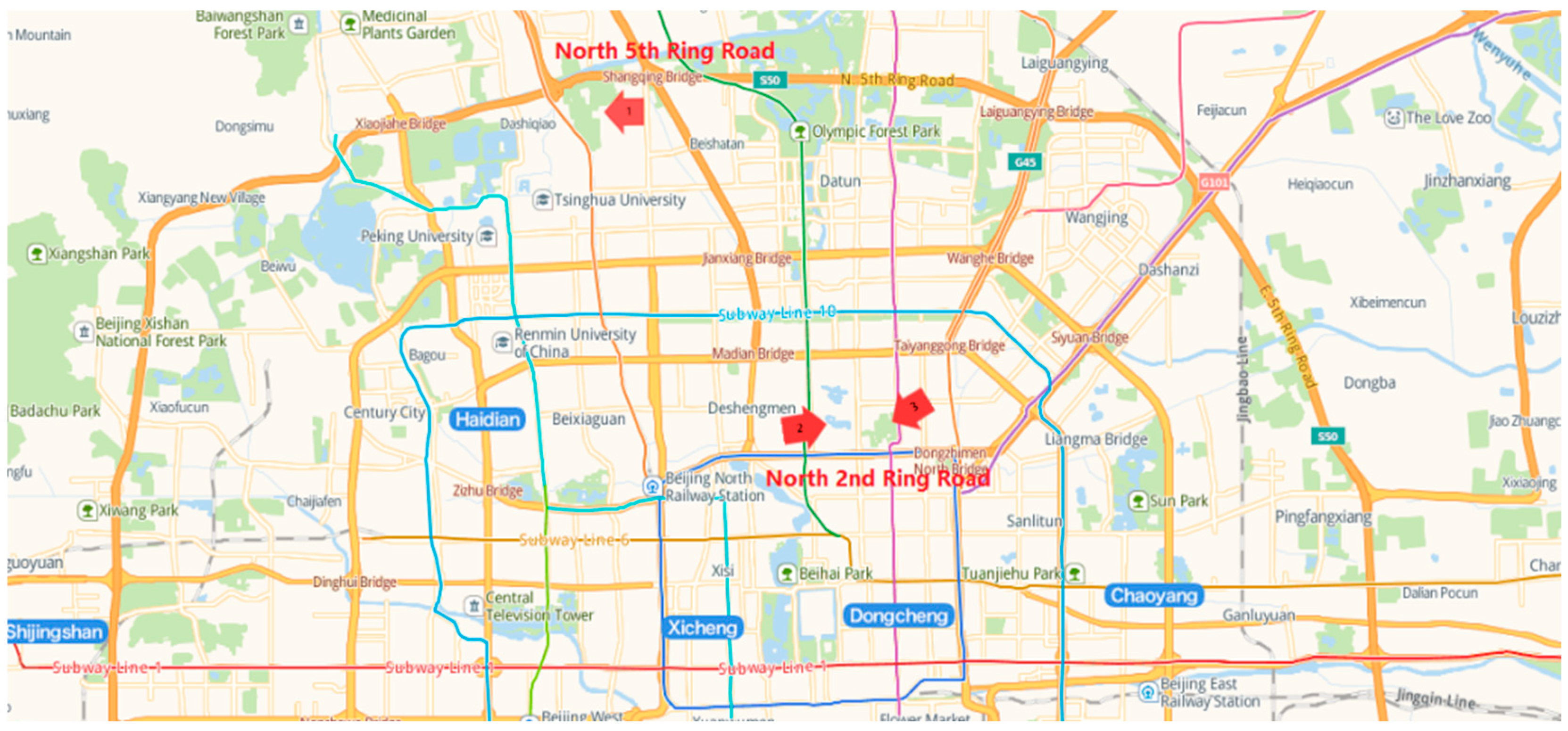
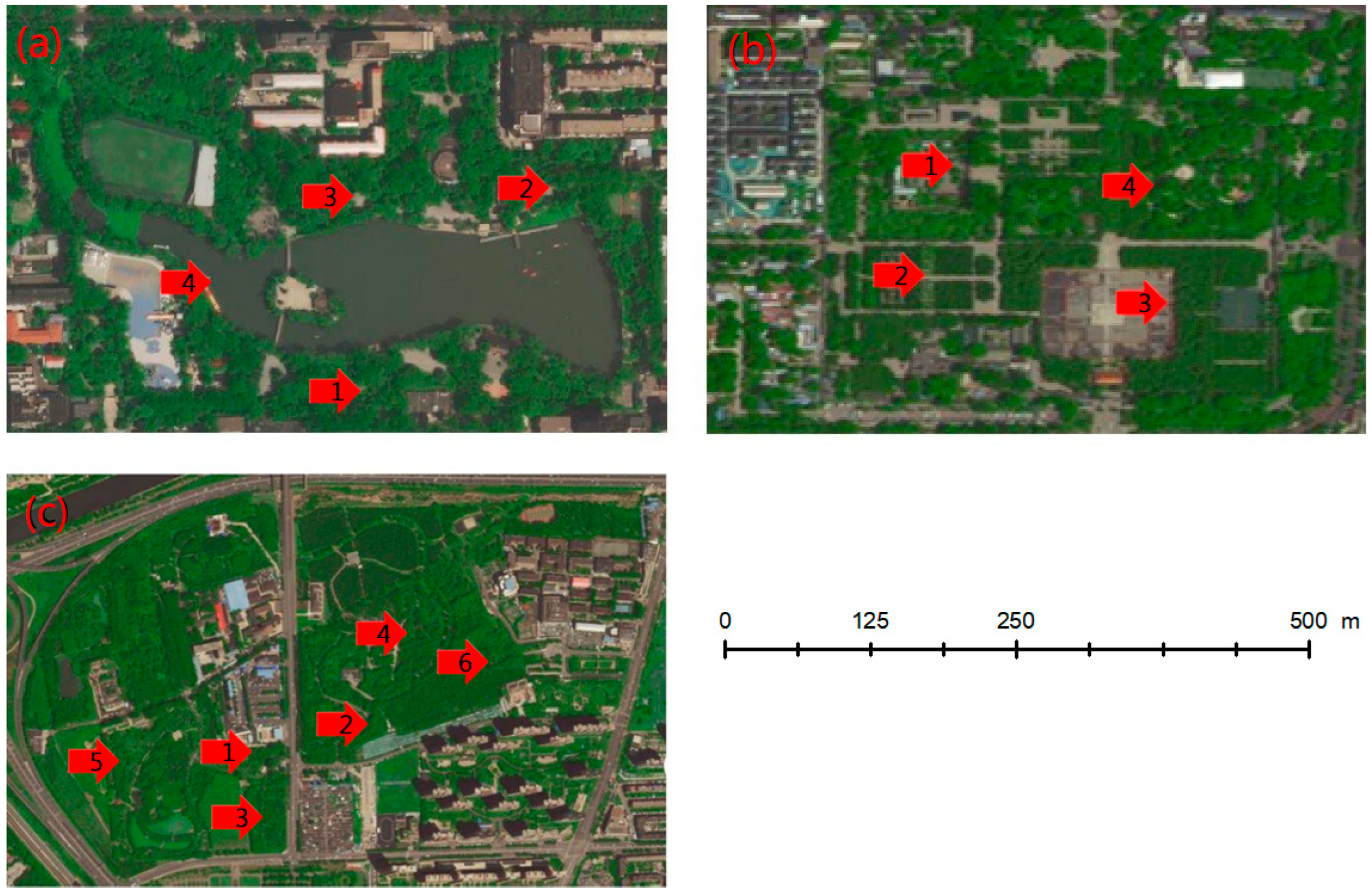
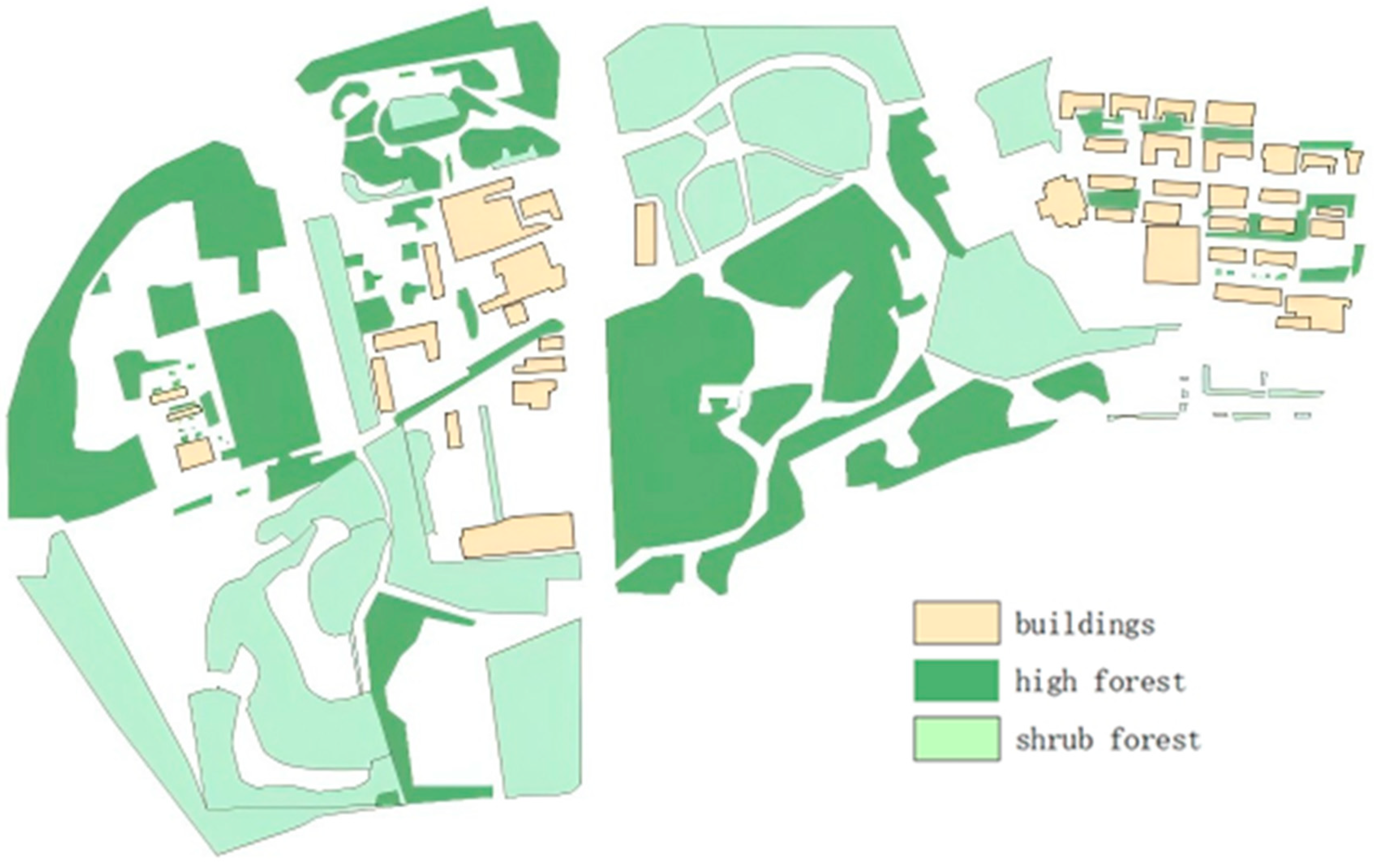

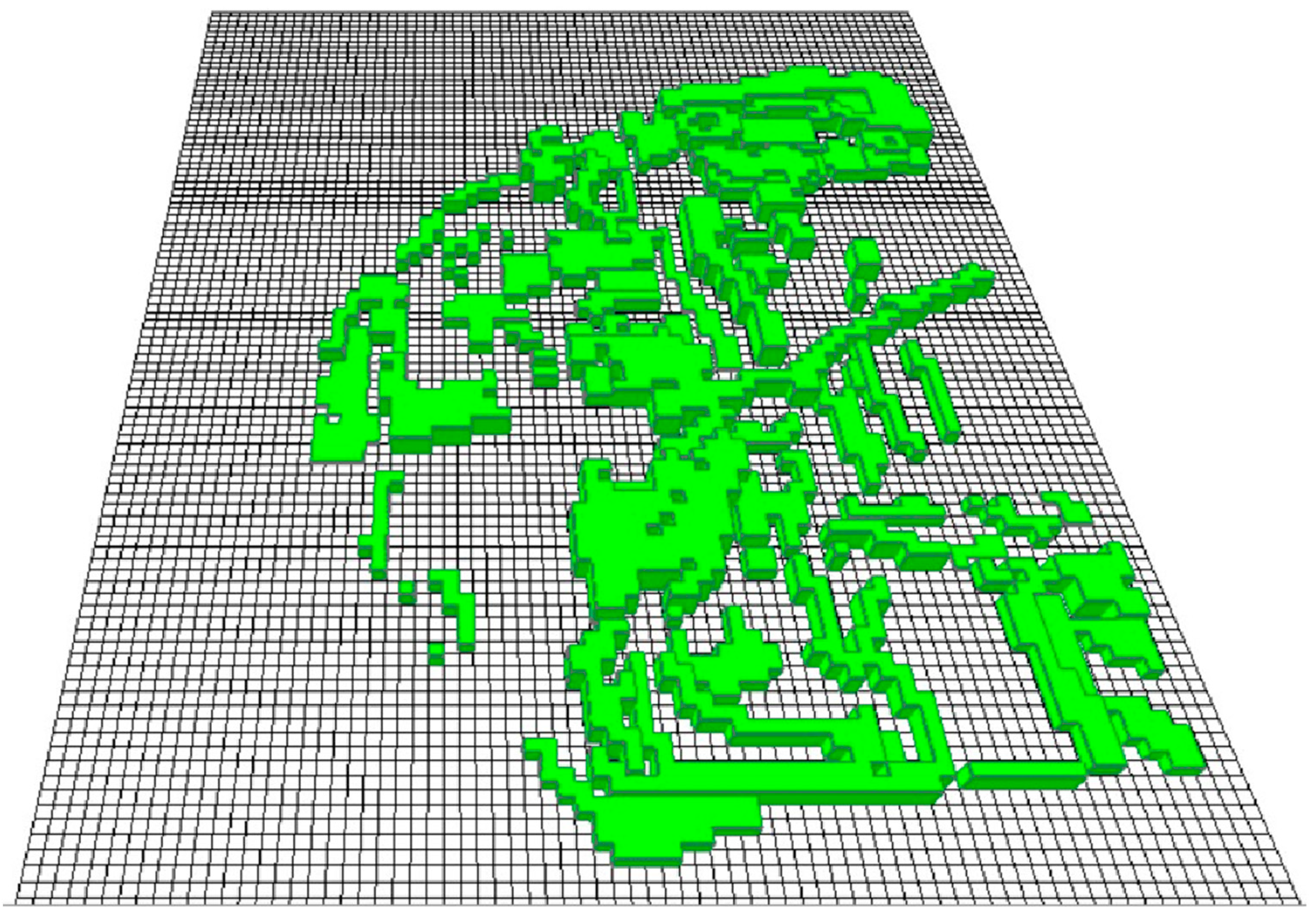
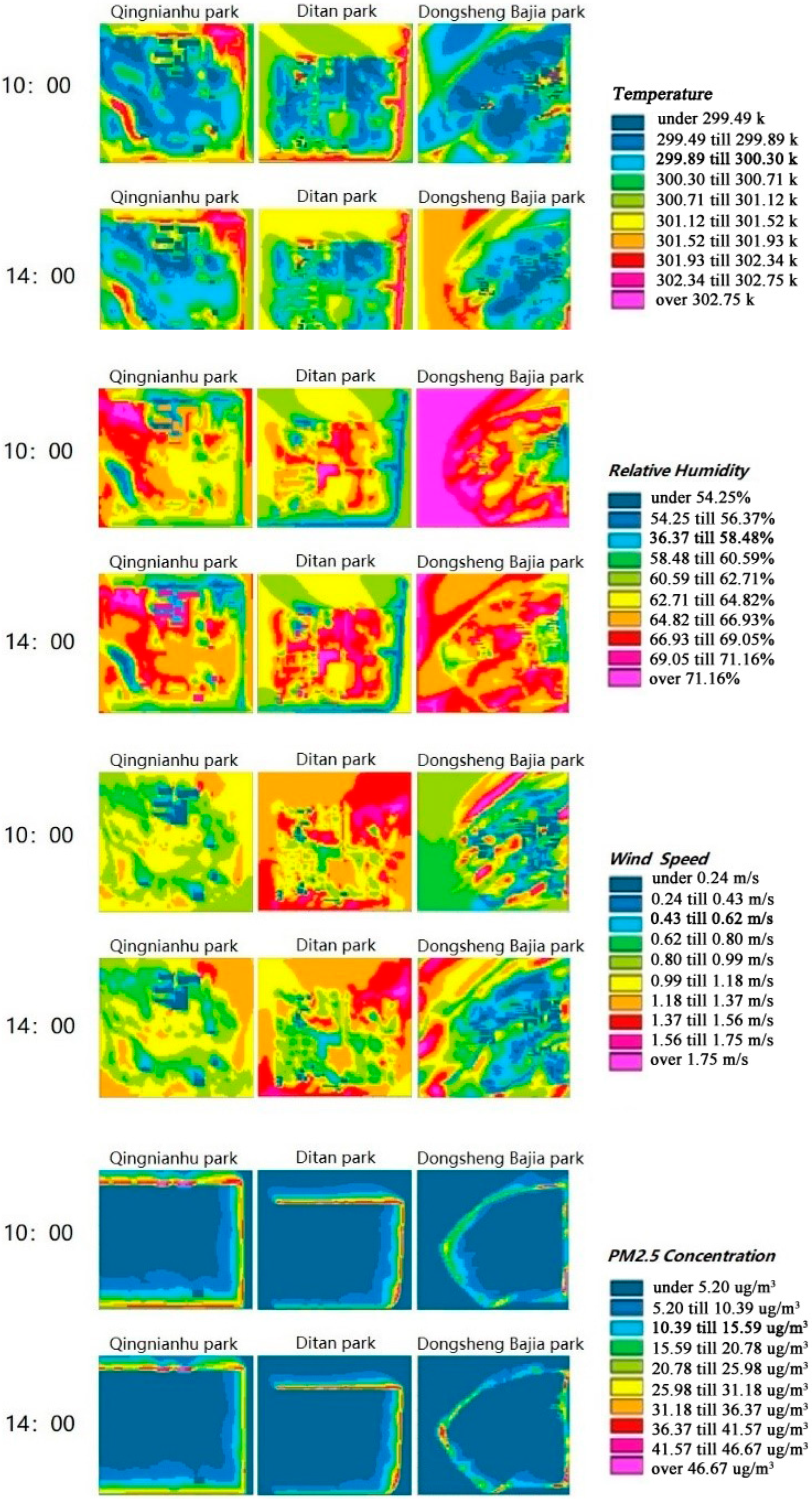

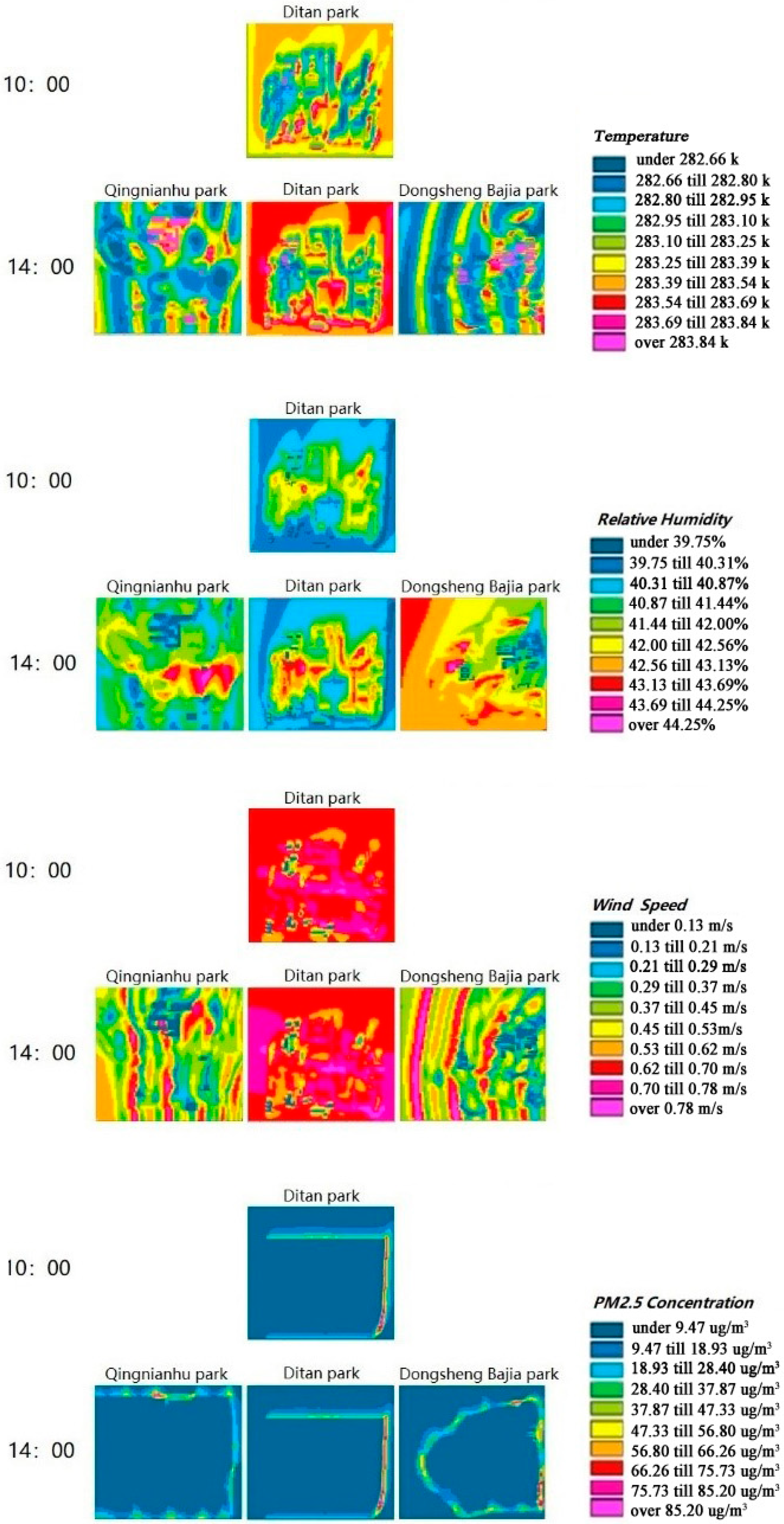

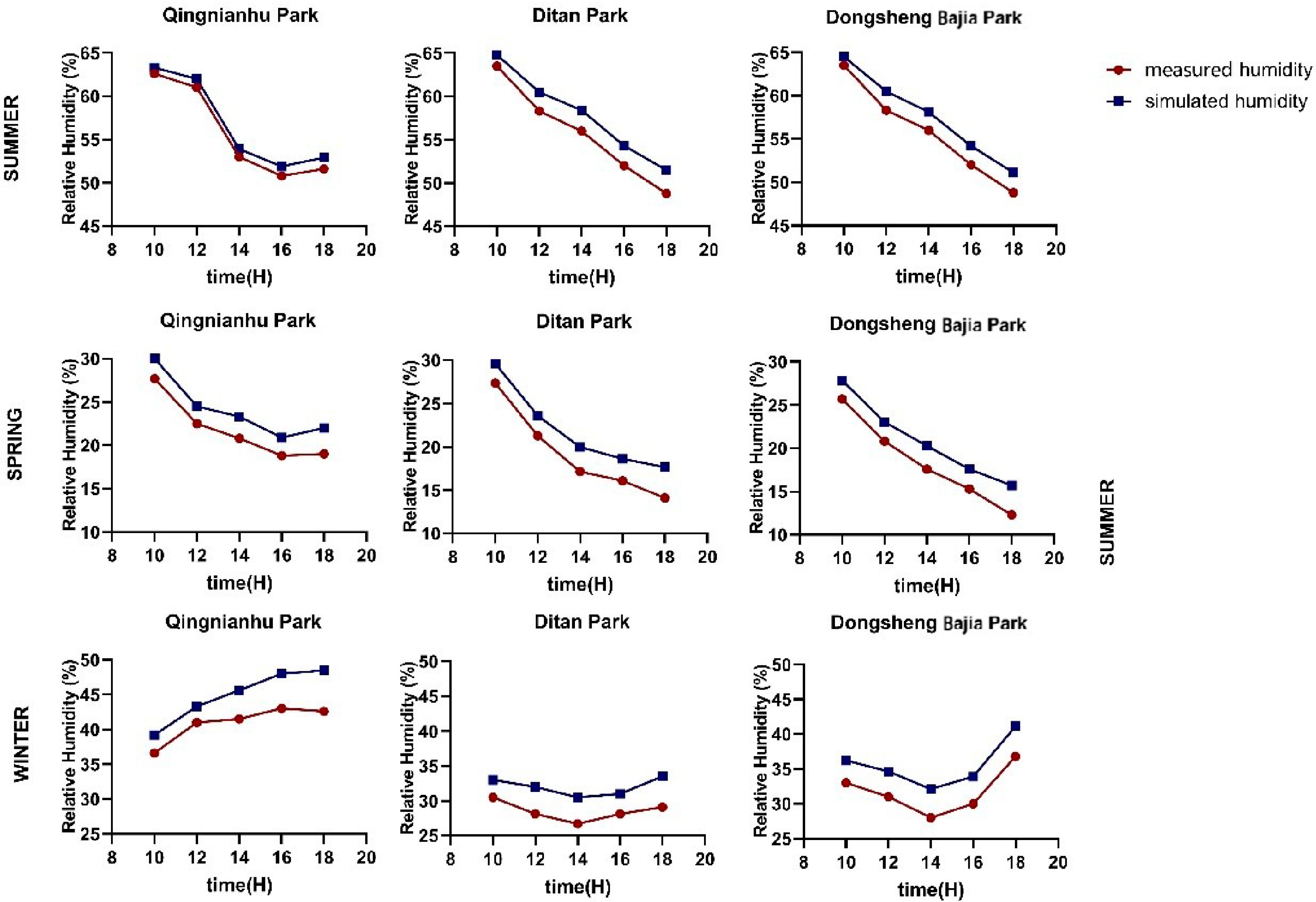
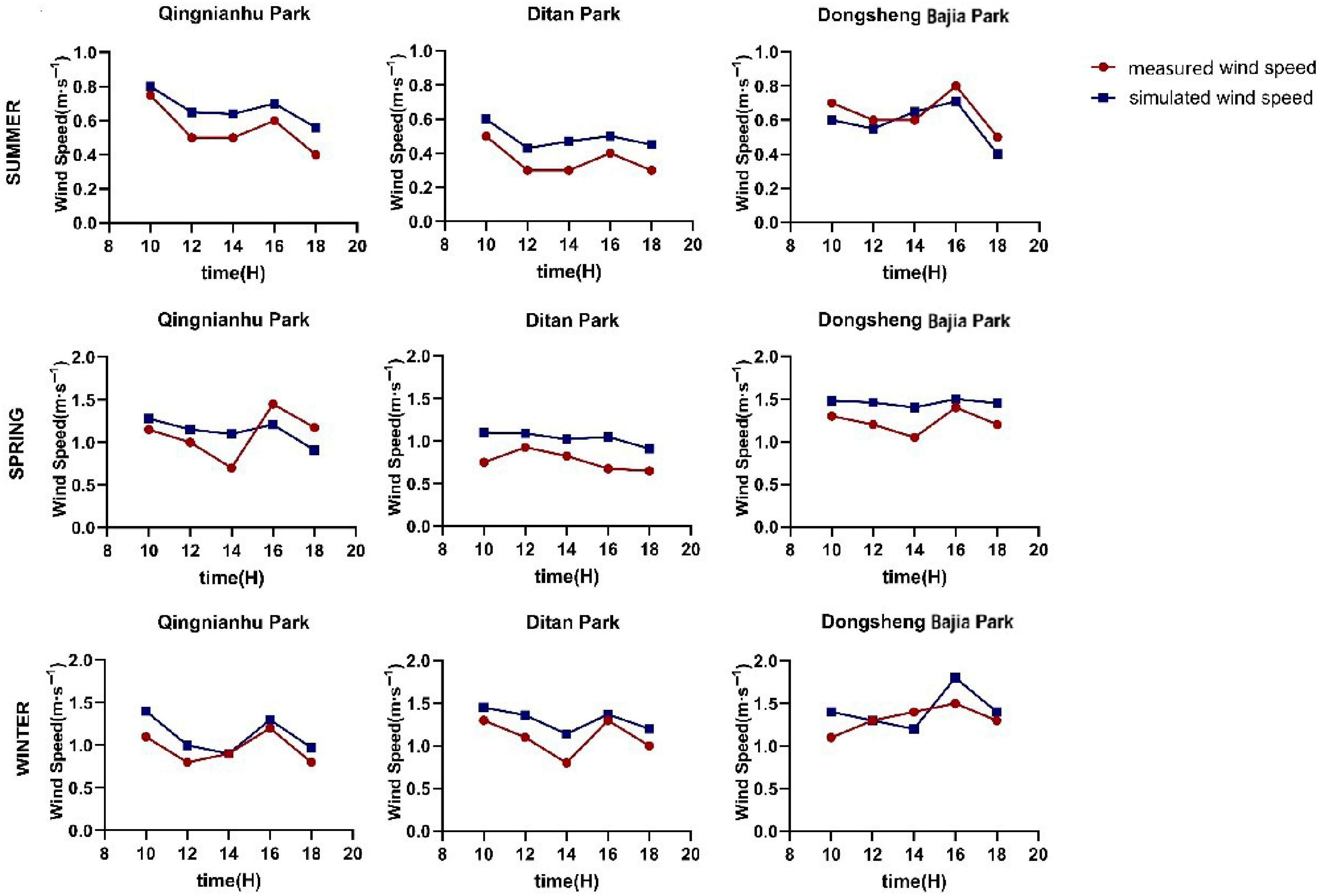
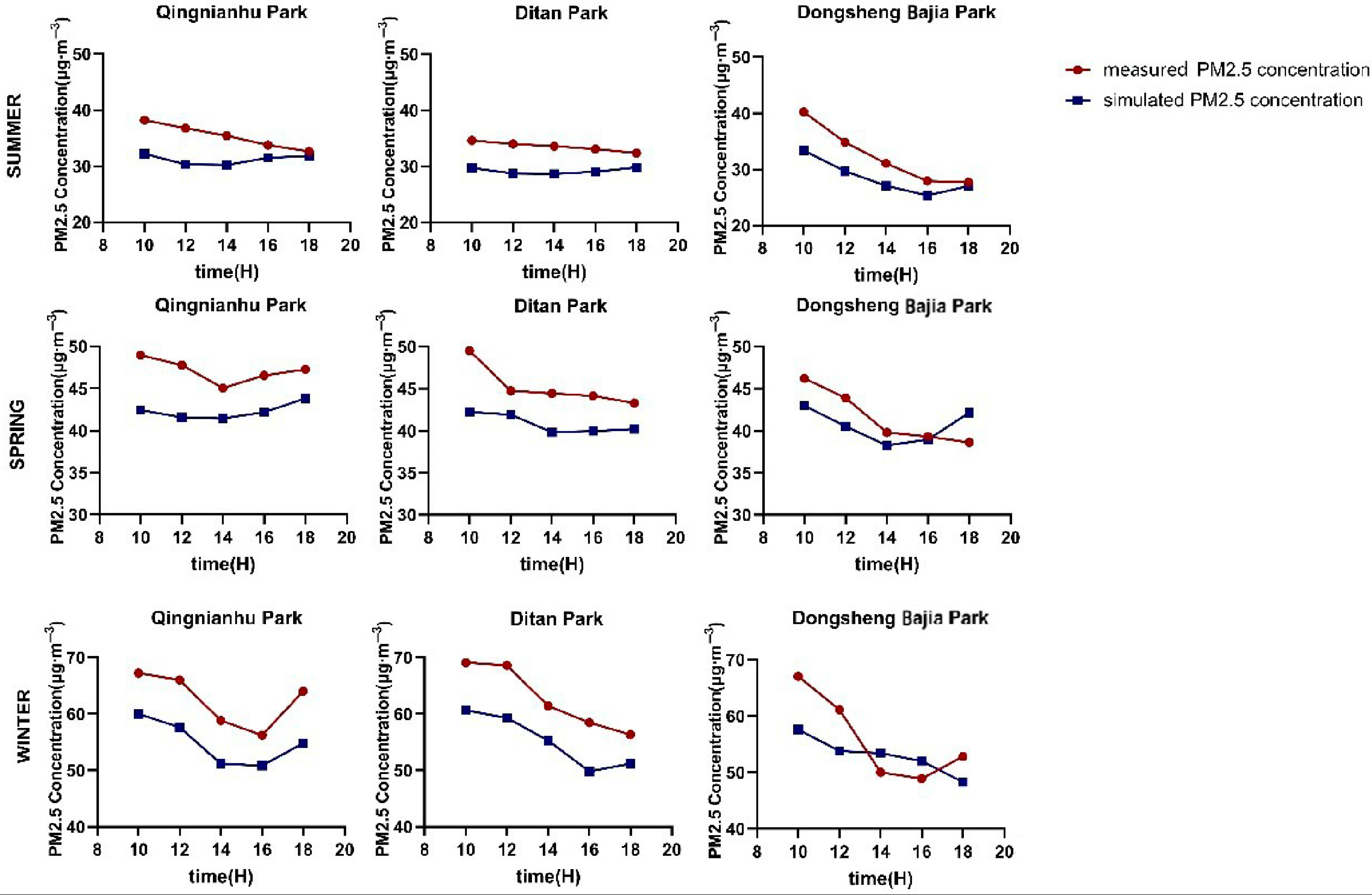
| Park | Area [ha] | Greening Rate [%] |
|---|---|---|
| Qingnianhu | 17 | 39.8 |
| Ditan | 37.4 | 62.43 |
| Dongsheng Bajia | 101.5 | 81.79 |
| Meteorological Factor | Equipment | Park | Number of Observatories |
|---|---|---|---|
| Temperature, relative humidity | Kestrel 4500 (Nielsen-Kellerman Co., Boothwyn, PA, USA) | Qingnianhu, Ditan, Dongsheng Bajia | 4, 4, 6 |
| Wind speed, wind direction | Kestrel 4500 (Nielsen-Kellerman Co., Boothwyn, PA, USA) | Qingnianhu, Ditan, Dongsheng Bajia | 4, 4, 6 |
| Concentration of PM2.5 | Dustmate (Turnkey Instruments Ltd., Cheshire, UK) | Qingnianhu, Ditan, Dongsheng Bajia | 4, 4, 6 |
| Tree height, building height | Bolulai altimeter (Bo Lu Lai Instrument Co., Shenzhen, China) | Qingnianhu, Ditan, Dongsheng Bajia | - |
| Park Name | Number of Grid Cells (x,y,z) | Size of Grid Cells (Meters) (x,y,z) |
|---|---|---|
| Qingnianhu | 100,75,30 | 5,5,3 |
| Ditan | 96,54,30 | 5,5,3 |
| Dongsheng Bajia | 75,100,30 | 5,5,3 |
| Parameter | Parameter Setting | |
|---|---|---|
| Base location | Beijing | 39.5° N, 116.2° E |
| Simulated time | Start time | 2 April 2019 8:00 |
| Duration | 10 h | |
| Meteorological condition | Inflow direction | 135° |
| Wind speed | 1.4 m/s | |
| Initial air temperature | 12°2 | |
| Relative humidity | 26% | |
| Pollutant | Species | PM2.5 |
| Source geometry | Linear | |
| Discharge height | 0.3 m | |
| Emission rate | 63.5 µg·s−1·m−1 | |
| Vegetation | LAD | 1–2 m2/m3 |
| Height | 2 m, 10 m, 15 m, 20 m | |
| Season | Parameter | RMSE/MAPE | ||
|---|---|---|---|---|
| Qingnianhu Park | Ditan Park | Dongsheng Bajia Park | ||
| Summer | Temperature (°C)/% | 0.59/2.56 | 0.40/1.52 | 0.39/1.48 |
| Relative humidity (%)/% | 1.84/4.82 | 1.56/4.01 | 2.05/4.91 | |
| Wind speed (m·s−1)/% | 0.20/15.02 | 0.21/15.60 | 0.25/16.50 | |
| PM2.5 (μg·m−3)/% | 5.62/6.66 | 5.97/6.92 | 5.58/6.59 | |
| Spring | Temperature (°C)/% | 0.67/2.98 | 0.89/3.59 | 0.68/3.05 |
| Relative humidity (%)/% | 2.49/5.50 | 2.40/5.27 | 3.02/5.63 | |
| Wind speed (m·s−1)/% | 0.26/16.70 | 0.16/14.20 | 0.11/12.70 | |
| PM2.5 (μg·m−3)/% | 7.03/7.62 | 6.87/7.13 | 8.04/8.91 | |
| Winter | Temperature (°C)/% | 0.58/2.38 | 0.53/2.03 | 0.99/3.80 |
| Relative humidity (%)/% | 3.10/5.99 | 2.90/4.62 | 3.11/5.72 | |
| Wind speed (m·s−1)/% | 0.27/16.91 | 0.24/16.41 | 0.31/17.74 | |
| PM2.5 (μg·m−3)/% | 9.12/10.33 | 8.46/9.07 | 7.18/7.70 | |
Disclaimer/Publisher’s Note: The statements, opinions and data contained in all publications are solely those of the individual author(s) and contributor(s) and not of MDPI and/or the editor(s). MDPI and/or the editor(s) disclaim responsibility for any injury to people or property resulting from any ideas, methods, instructions or products referred to in the content. |
© 2025 by the authors. Licensee MDPI, Basel, Switzerland. This article is an open access article distributed under the terms and conditions of the Creative Commons Attribution (CC BY) license (https://creativecommons.org/licenses/by/4.0/).
Share and Cite
Xiong, N.; Song, H.; Zhou, F.; Yan, Y.; Jia, J.; Li, Q.; Liu, D.; Wang, J. Simulation of Microclimate and PM2.5 Dispersion in Typical Urban Parks in Beijing Based on the ENVI-Met Model. Sustainability 2025, 17, 7247. https://doi.org/10.3390/su17167247
Xiong N, Song H, Zhou F, Yan Y, Jia J, Li Q, Liu D, Wang J. Simulation of Microclimate and PM2.5 Dispersion in Typical Urban Parks in Beijing Based on the ENVI-Met Model. Sustainability. 2025; 17(16):7247. https://doi.org/10.3390/su17167247
Chicago/Turabian StyleXiong, Nina, Huayang Song, Fei Zhou, Yuna Yan, Junru Jia, Qian Li, Deqing Liu, and Jia Wang. 2025. "Simulation of Microclimate and PM2.5 Dispersion in Typical Urban Parks in Beijing Based on the ENVI-Met Model" Sustainability 17, no. 16: 7247. https://doi.org/10.3390/su17167247
APA StyleXiong, N., Song, H., Zhou, F., Yan, Y., Jia, J., Li, Q., Liu, D., & Wang, J. (2025). Simulation of Microclimate and PM2.5 Dispersion in Typical Urban Parks in Beijing Based on the ENVI-Met Model. Sustainability, 17(16), 7247. https://doi.org/10.3390/su17167247







